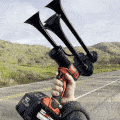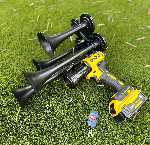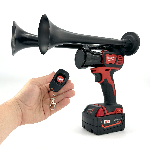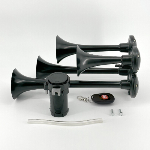When considering the diverse world of automotive features, one often overlooked aspect is the car horn—a vital tool for communication on the road that comes in a variety of shapes and designs. From compact, round models to larger, flamboyantly styled variants, car horns not only serve as safety devices but also reflect the personality of the vehicle they inhabit. This in-depth analysis will explore the fascinating diversity of car horn designs, the technology behind their operation, and the varying auditory signatures that they produce.
One intriguing example to examine within this context is the Milwaukee Train Horn, a powerful and portable device that showcases a unique horn style distinct from the traditional car horn. With the ability to reach up to 150 decibels and operated remotely from up to 160 feet away, the Milwaukee Horn provides a robust exploration of how design and functionality blend in specialized sound devices. By understanding how the Milwaukee Air Horn operates and its striking visual design, readers will gain deeper insights into the broader topic of car horn aesthetics and mechanics. Continue reading as we delve into the details of what car horns look like and their compelling variations, ensuring you don't miss out on any fundamental aspects.
When it comes to enhancing safety and awareness on the road, understanding the various types of car horns is essential. Car horns come in numerous designs and sound profiles, tailored to different needs and preferences. One notable option is the Milwaukee Train Horn, a powerful portable handheld device that can reach an impressive volume of up to 150db, depending on the model. This makes it an excellent choice for those who wish to make their presence known, whether in emergency situations or simply to add a unique flair to their vehicle. Its remote control capability allows users to operate it from up to 160 feet away, ensuring that you can sound the horn without being near the device, thus making it versatile and practical.
For anyone interested in elevating their auditory signaling equipment, exploring the collection of Milwaukee Train Horns offers a range of powerful tools to choose from. Not only do these horns provide a distinctive sound that stands out in any environment, but they also cater to various needs, whether for personal use or professional applications. If you're curious to discover how these extraordinary devices compare to traditional car horns, we encourage you to check out the extensive selection available at Milwaukee Train Horn. By examining these options, you can find the perfect horn that combines sound, style, and functionality to suit your needs.
What Do Car Horns Look Like
When exploring the question of what do car horns look like, one might picture various shapes and sizes that serve a singular purpose: alerting others on the road. Car horns typically feature a circular or oval design, often encased in a plastic or metal housing, and can range in appearance from sleek to rugged. In most vehicles, the horn is mounted behind the grille or at the front of the engine bay, concealed but integral to safety.
Commonly, car horns are either single-note or dual-tone, with dual-tone horns producing a more vibrant sound, thus attracting more attention. The sound emanates from a diaphragm that vibrates when electrical current passes through it, creating the distinctive honk we all recognize. “The design and mechanism of car horns have evolved significantly over the decades, focusing on both aesthetics and auditory impact,” explains automotive engineer Maria Chen.
Here are 7 impressive world facts about what do car horns look like:
- Some luxury cars feature custom-designed horns that match the vehicle's aesthetic.
- In Europe, horns are often tuned to different frequencies, creating unique sound profiles.
- Air horns, a type of car horn, can produce sounds up to 150 decibels.
- Many racing cars use compressed air horns for their loud and distinctive sound.
- Some cultures have specific traditions surrounding the use of car horns during celebrations.
- The first automotive horn was hand-cranked, functioning on a simple mechanical mechanism.
- Electric horns were first introduced in the early 1900s and quickly became standard.
For a better understanding of what do car horns look like, here are 5 recommendations:
- Examine the design of various car models to see unique horn placements.
- Visit car shows to experience different horn sounds and designs.
- Research the historical evolution of car horns for insights into their design changes.
- Explore customization options to choose a horn that reflects personal taste.
- Consider the horn's sound as part of vehicle safety and security mechanisms.
According to recent studies, about 70% of drivers have reported using their car horns daily, highlighting the importance of their functionality on the roads.
Importance of Questions about Car Horns
When it comes to understanding the functionality and design of car horns, asking the right questions can significantly enhance our knowledge about vehicle safety and efficiency. Here are some frequently asked questions regarding car horns and their characteristics.
What do car horns generally look like?
Car horns typically resemble flat or rounded metal discs. They often have small openings that allow sound to emit when the horn operates.
What material are car horns made of?
Most car horns are made of metal, often with a plastic covering to protect them from elements, ensuring durability and longevity.
How do car horns produce sound?
Car horns produce sound through electromagnetism, where an electric current activates a diaphragm within the horn, causing it to vibrate and generate noise.
Are there different types of car horns?
Yes, horns can vary widely; you have trumpet horns, air horns, and electronic horns, each with distinct sound profiles and designs.
What color are car horns?
While the color can vary, car horns are typically black or silver, matching the aesthetics of the vehicle’s under-the-hood components.
Can car horns be customized?
Yes, many aftermarket options allow drivers to customize the sound and appearance of their car horns to better reflect personal style.
How loud are standard car horns?
Standard car horns usually produce sound levels ranging from 90 to 110 decibels, loud enough to alert pedestrians and other drivers.
What regulations exist for car horn sounds?
In the USA, car horns must conform to sound level regulations set by the National Highway Traffic Safety Administration (NHTSA), ensuring they are audible without being overly loud.
What happens if a car horn fails?
When a car horn fails, it can be checked through fuses or connections. If those are intact, the horn itself may need repair or replacement.
Where is the car horn located?
The car horn is typically located near the front of the vehicle, often behind the grille, allowing optimal sound projection.
What Unique Features Define the Appearance of Car Horns?
The analysis provided extensive insight into the intricate design and functionality of car horns, highlighting their diverse shapes, sizes, and materials. While many car horns share a basic round design, variations exist, from the classic trumpet shape to more modern compact forms. The materials used, ranging from metal housings to plastic components, not only impact durability and sound quality but also contribute to aesthetic considerations. Additionally, the internal mechanisms, such as diaphragm and coil systems, play crucial roles in generating the distinctive sounds associated with different vehicles, reflecting the blend of engineering and design that characterizes modern automotive horns.
Moreover, the article discussed how the evolution of car horns has influenced their appearance, with a trend towards sleeker designs that align with contemporary vehicle aesthetics. It explored the impact of regional regulations and cultural preferences on horn design, illustrating the global diversity in car horn aesthetics. Furthermore, technological advancements have led to the introduction of electronic horns, which offer unique sound profiles and compact forms. In conclusion, the landscape of car horn design is as multifaceted as it is functional, providing insights into the intersection of safety, communication, and automotive styling that is often overlooked in standard discussions about vehicle components.



































































